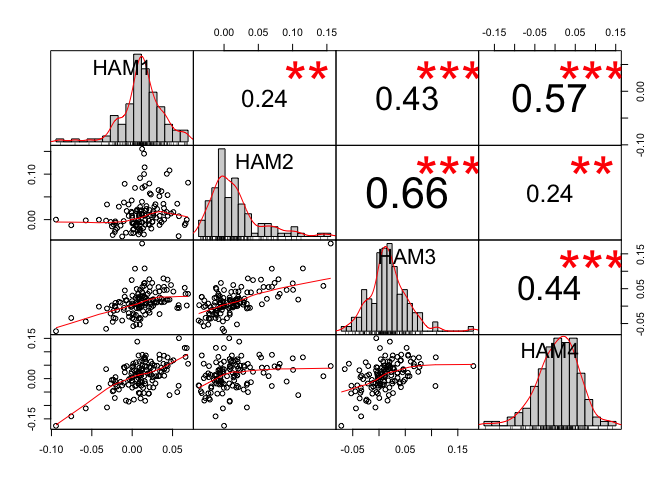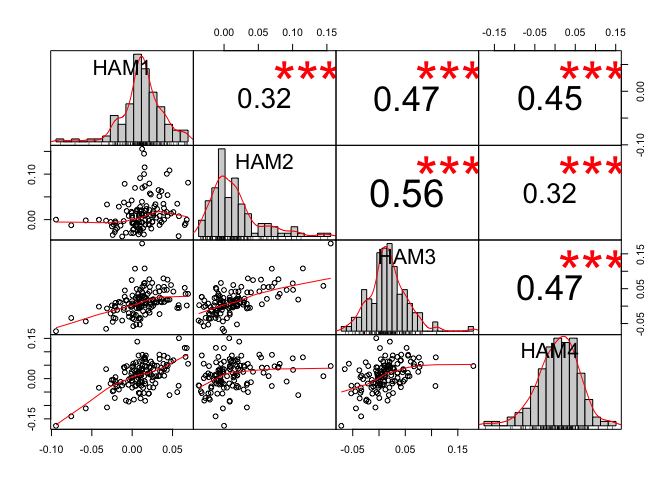As Andrés mentioned before, please, try to use 'reprex ' (FAQ ) in future. It's a cool tool to post your questions to the R-communtiy. It helps us to help you! ![]()
Based on your first request a possible solution in a reprex ![]()
library(PerformanceAnalytics)
data(managers)
head(managers[,1:4], n = 10)
#> HAM1 HAM2 HAM3 HAM4
#> 1996-01-31 0.0074 NA 0.0349 0.0222
#> 1996-02-29 0.0193 NA 0.0351 0.0195
#> 1996-03-31 0.0155 NA 0.0258 -0.0098
#> 1996-04-30 -0.0091 NA 0.0449 0.0236
#> 1996-05-31 0.0076 NA 0.0353 0.0028
#> 1996-06-30 -0.0039 NA -0.0303 -0.0019
#> 1996-07-31 -0.0231 NA -0.0337 -0.0446
#> 1996-08-31 0.0395 -0.0001 0.0461 0.0351
#> 1996-09-30 0.0147 0.1002 0.0653 0.0757
#> 1996-10-31 0.0288 0.0338 0.0395 -0.0180
#modified function chart.Correlation2(...)
chart.Correlation2 <- function (R, histogram = TRUE, method = NULL, ...){
x = checkData(R, method = "matrix")
if (is.null(method)) #modified
method = 'pearson'
use.method <- method #added
panel.cor <- function(x, y, digits = 2, prefix = "", use = "pairwise.complete.obs",
method = use.method, cex.cor, ...) { #modified
usr <- par("usr")
on.exit(par(usr))
par(usr = c(0, 1, 0, 1))
r <- cor(x, y, use = use, method = method)
txt <- format(c(r, 0.123456789), digits = digits)[1]
txt <- paste(prefix, txt, sep = "")
if (missing(cex.cor))
cex <- 0.8/strwidth(txt)
test <- cor.test(as.numeric(x), as.numeric(y), method = method)
Signif <- symnum(test$p.value, corr = FALSE, na = FALSE,
cutpoints = c(0, 0.001, 0.01, 0.05, 0.1, 1), symbols = c("***",
"**", "*", ".", " "))
text(0.5, 0.5, txt, cex = cex * (abs(r) + 0.3)/1.3)
text(0.8, 0.8, Signif, cex = cex, col = 2)
}
f <- function(t) {
dnorm(t, mean = mean(x), sd = sd.xts(x))
}
dotargs <- list(...)
dotargs$method <- NULL
rm(method)
hist.panel = function(x, ... = NULL) {
par(new = TRUE)
hist(x, col = "light gray", probability = TRUE, axes = FALSE,
main = "", breaks = "FD")
lines(density(x, na.rm = TRUE), col = "red", lwd = 1)
rug(x)
}
if (histogram)
pairs(x, gap = 0, lower.panel = panel.smooth, upper.panel = panel.cor,
diag.panel = hist.panel)
else pairs(x, gap = 0, lower.panel = panel.smooth, upper.panel = panel.cor)
}
#if method option not set default is 'pearson'
chart.Correlation2(managers[,1:4], histogram=TRUE, pch="19")

chart.Correlation2(managers[,1:4], histogram=TRUE, pch="19", method = 'spearman')
#> Warning in cor.test.default(as.numeric(x), as.numeric(y), method = method):
#> Cannot compute exact p-value with ties

Created on 2019-03-15 by the reprex package (v0.2.1)